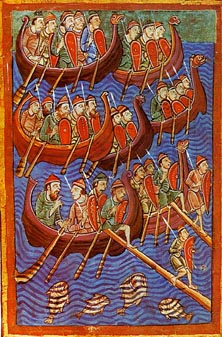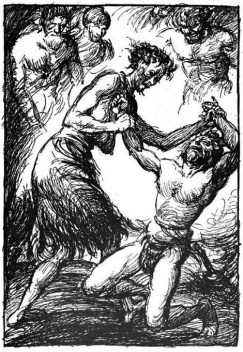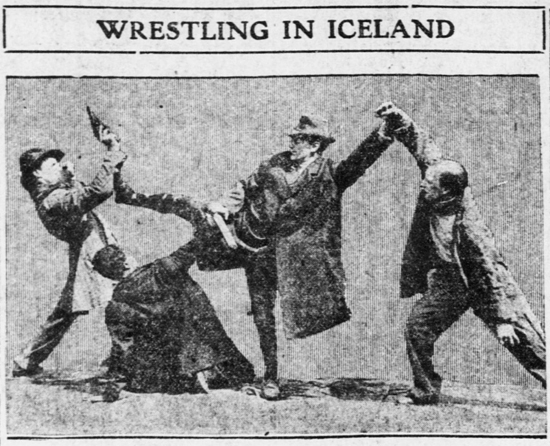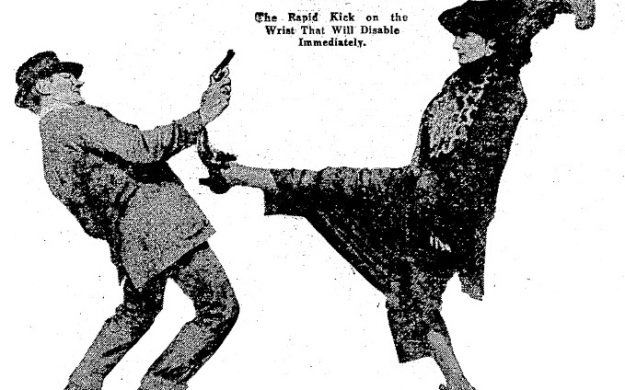|
Vikings (Danish and Bokmål: vikinger; Swedish and Nynorsk: vikingar; Icelandic:víkingar,from Old Norse víkingr, were Norse seafarers, speaking the Old Norse language, who raided and traded from their Scandinavian homelands across wide areas of northern, central and eastern Europe, during the late 8th to late 11th centuries. The term is also commonly extended in modern English and other vernaculars to the inhabitants of Viking home communities during what has become known as the Viking Age. This period of Norse military, mercantile and demographic expansion constitutes an important element in the early medieval history of Scandinavia, the British Isles, France, Kievan Rus' and Sicily. Vikings was in there time famous warriors. Did they have some martial art? Yes, they have it and it’s call glima. Glíma is the name of the Scandinavian martial arts system used by the Vikings. The word glíma in Old Norse means glimpse or flash, which describes the systems techniques. Glima as a self-defence system contains throws, blows, kicks, chokes, locks, pain techniques and weapon techniques, and is comparable with the best complete martial arts systems from around the world. Glima as self-defence was the foundation for the Viking warrior. Glima was the most widespread sport in the Viking Age, and was practiced by men and women of all ages. . This style of combat training helped develop the strength, reflexes, endurance and courage that Viking warriors needed to survive in combat. Glima also builds self confidence and for Norse children, Glima training usually began at around 6 or 7 years of age. Wherever Vikings gathered, Glima was a big part of the entertainment. Glima was so important for Viking society that their most popular god, Thor, was also the Viking god of wrestling. In order to have a structured form of unarmed combatives against weapons, the Vikings had to know how to use a variety of weapons, such as sword, axe, spear, seax, stick and knife. Through combat glima, Vikings became experts in knife fighting, stick fighting, spear fighting, axe fighting and sword fighting. Training in glima with and without weapons from an early age, gave the Vikings such a comprehensive combat foundation, that they had no problem adapting to the different styles of warfare, or other fighting styles they met on their travels. Viking warriors were renowned for their fighting abilities in raids and against larger and less mobile soldiers because glima, combined with forestry and hunting skills, made Vikings extremely dangerous in guerilla warfare. In the Middle East in the year 922, Muslim diplomat Ibn Fadlan wrote that he had never seen more perfect physical specimens than Viking warriors, and that they were the fiercest fighters he had ever seen.Glima is first mentioned in Viking poetry by the Norwegian court poet Bragi Boddason (790-850) and Kveldúlfr Bjálfason (820-878), also of Norwegian Heritage. The poetry is about the Norse god Thor and his journey to Utgards-Loki, where Elli defeats Thor in a wrestling match. Glima is also mentioned in Prose Edda the Icelandic collection of texts from 1220, and in the book Gylfaginning, when the god Thor took his journey to Utgards-Loki and was defeated in a wrestling match by the female jötunn Elli (Old Norse “Elli” means “old age”). Yes, Thor was beaten by an old woman in hand to hand unarmed combat. Þagalt og hugalt skyldi þjóðans barn og vígdjarft vera. Glaður og reifur skyli gumna hver uns sinn bíður bana. People should be quiet and thoughtful and brave in conflict Each person should live happy and joyful until their last day. Hávamál – Verse 15 Vikings was in there time famous warriors. Did they have some martial art? Yes, they have it and it’s call glima. A depiction of Elli wrestling Thor (1919) by Robert Engels Glima can be deviated in two categories. Combat glima and sport glima. First we shall talk about combat glima. Lausatök is the most aggressive form of armed and unarmed Glima and it is the form of glima used for self-defence and combat. In new times it was added sport version. In such training, the harmful and hurtful techniques, or ways of executing the techniques, that are not accepted in other forms of Viking wrestling, are explored in as free and creative a way as possible while not injuring the training partner. In a friendly (sport) Lausatök match, the winner is considered the one who is standing tall while the other is lying on the ground. This means that if both the opponents fall to the ground together the match will continue on the ground by the use of techniques to keep the other down while getting up. Lausatök as a self-defense system contains throws, grappling, blows, kicks, chokes, locks, pain techniques and weapon techniques, and is comparable with the best complete martial arts systems from around the world. Lausatök for combat was the basis for the Vikings fighting expertise and includes techniques against weapons. In order to have a structured form of unarmed combative against striking weapons, the Vikings had to know how to use a variety of weapons, such as sword, axe, spear, seax, long seax, and knife. Lausatok grip makes for better control of weapons, especially the Viking sword. Not only does the lausatok grip on Viking weapons make for much more dexterous maneuvers than with a 4 finger ‘hammer’ grip, it gives the index finger control of the sword in a way that is impossible with a full four finger grip. Working the index finger against the crossguard in unison with the three fingered grip on the sword grip, provides better control and precision, and increases the maneuverability and versatility of the Viking sword. The lausatok grip guides and controls cuts, blocks, parries and disarms with dexterity and effectiveness. Being so versatile, the lausatok grip can range from loose to firm control without cramping the hand or arm or the versatility of the weapon, and provides the supple and active grip needed to hold and use a Viking sword to the full. The lausatok grip works with long and short Viking sword grips, and can be a lot more effective than a regular hammer grip, which isn’t so precise or versatile. In fact, the glima grip is so effortless when used correctly that it makes the hammer grip seem clumsy with slow recovery in comparison. Glima in street action The sport variants of Glíma wrestling, called Brokartök, Hryggspenna, and Lausatök, have complex rules with competitors divided into several classes based on strength and skill. Brokartök (Trouser-grip) form of glima favors technique over strength. Each of the two wrestlers wear a special belt around the waist and separate additional belts on the lower thighs of each leg, which connect to the main belt with vertical straps. A fixed grip is then taken with one hand in the belt and the other in the trousers at thigh height. From this position the glima-wrestler attempts to trip and throw his opponent. In this style of glima, a thrown wrestler may attempt to land on his feet and hands and if he succeeds in doing so he has not lost the fall. The winning condition in this type of glima is to make the opponent touch the ground with an area of the body between the elbow and the knee. There are four points that differentiate Brokartök from other forms of wrestling: the opponents must always stand erect, the opponents step clockwise around each other (looks similar to a waltz). This is to create opportunities for offense and defense and to prevent a stalemate, it is not permitted to fall down on your opponent or to push him down in a forceful manner, as it is not considered sportsman-like, the opponents are supposed to look across each other’s shoulders as much as possible because it is considered proper to wrestle by touch and feel rather than sight. The core of the system are eight main brögð (techniques) which form the basic training for approximately 50 ways to execute a throw or takedown. Brokartök glíma is different from all other ethnic grips in three ways: 1. Upprétt staða Pursuers shall remain upright. The positioning in many of the ethnic grips sports often resembles a setsquare but in Brokartök glíma that is called ousting or “bol” and is banned. 2. Stígandinn Brokartök glíma involves steps, which involves contestants stepping forth and back like they are dancing in a clockwise motion. Stígandi is one of the characteristics of Glíma and designed to avoid a standstill and create opportunities for offence and attack. 3.Níð It is forbidden in Brokartök glíma to tail your opponent to the floor or push your opponent down with force. That is considered to be unsportsmanlike and opposing the nature of Glíma as a sport for honorable sportsmen and women. The Brokartök glíma sportsman or sportswoman shall conquer his or her opponent with a Glíma grip so well implemented that it suffices in a “bylta”, which forces your opponent to fall to the ground without any further action. The concept “níð” does not exist in other ethnic grip sports. Hryggspenna (Backhold wrestling) is more similar to other styles of wrestling and is considered to be more a test of strength than of technique. In Hryggspenna the opponents take hold of each other’s upper body and whoever touches the ground with any part of the body except the feet has lost. Lausatök (Loose-Grip or Free-Grip) all kinds of wrestling techniques are allowed, but in the friendly version they are still taught to be executed in a way so they won’t cause the opponent injury. In such a friendly match the winner is considered the one who is standing tall while the other is lying on the ground. This means that if both the opponents fall to the ground together the match will continue on the ground by the use of techniques to keep the other down while getting up. Excessive use of techniques aimed at deliberately injuring an opponent is frowned upon in sport Lausatök glíma. It is enough to use glima techniques that send an opponent to the floor, to inflict ‘pain’on the floor, to ‘slap’ and opponent as opposed to ‘punch’ and kicks aimed at shockingan opponent rather than breaking bones. Such actions are considered níð; unsportsmanlike and opposing the nature of Glíma as a sport for honorable sportsmen and women. The concept “níð” does not exist in other ethnic grip sports. Ms. Caroline Josefsson presents the art of Scandinavian wrestling in 1914.
2 Comments
|
MarkoUndermaster of historical fencing ArchivesCategories
All
|




 RSS Feed
RSS Feed
